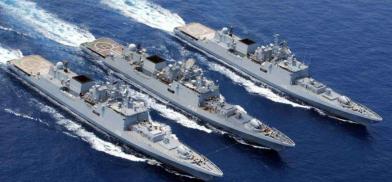China-Pakistan naval axis to contain India's dominance in IOR
China is enabling Pakistan to set up a network-enabled warfare capability with satellite feeds to monitor the Indian Ocean Regions (IOR) like the Indian Navy employs Centrix provided by the US Navy, writes Cmde Ranjit B. Rai (retd) for South Asia Monitor

On October 7, Admiral Zafar Mahmoud Abbasi handed over the telescope of the Pakistan Navy (PN) to Admiral Muhammad Amjad Khan Niazi as PN’s 17th Chief of Naval Staff at a parade at PNS Zafar Karachi. Admiral Niazi has headed the F-22 Mission in China and has a master’s degree in underwater acoustics from Beijing University. At the change of command Admiral Abbasi profiled Pakistan Navy’s 50 Ship Vision - 2030, across its surface, sub-surface, and aviation domains with details of platforms being supplied by China and Turkey, the two close allies of Pakistan, and those to be built in Pakistan with their help.
The PN plans to operationally re-deploy its ships in three task forces at Karachi, Gwadar, and Ormara, and activate the three naval air stations there for the day and night operations. The PN is revising its Creek security strategy to focus on offensive operations employing integrated strike groups comprising of both Marines and Special Operations Forces (SOF).
China enabling Pakistan Navy
As Sir Creek borders India and is disputed, there seems more at play than just deploying rapid action assets. PN is enlarging its marines, which now operates from Gwadar into a division-sized force. China funds the marines defending Chinese interests at Gwadar and PN’s Special Service Group Navy (SSGN) originally trained by US Seals is planned to grow into a brigade-sized force by 2023. China is enabling Pakistan to set up a network-enabled warfare capability with satellite feeds to monitor the Indian Ocean Regions (IOR) like the Indian Navy employs Centrix provided by the US Navy.
In PN’s 50 ship plan, 20 are major warships and includes four China supplied Type 054A/P frigates with C-802 anti-ship missiles, HQ anti-air systems, and ship-borne Harbin Z-9 utility helicopters, the licensed variant of the French Eurocopter AS365 Dauphin, for delivery between 2021 to 2023. Turkey is supplying four Milgen corvettes named Jinnah class from 2023 to 2025, fitted with missiles and Chinese 16-cell vertical launch anti-missile system (VLS HHQ-16). PN has already inducted its first 2,300-ton corvette from Damen’s Romanian facility in early 2020, and the second ship, PNS Tabouk, will join in November.
PN’s road map to ‘Make in Pakistan’ includes four F-22P frigates, and follow up the Jinnah-class frigates at the Karachi Shipyard and Engineering Works(KSEW) and Abbasi said six ships of larger tonnage have been identified.
Submarine plans
Pakistan operates five Agosta submarines (two with AIP) and three X Craft Midgets from Cosmos Italy and has plans for a total of eight Hangor (Yuan) class submarines with air-independent propulsion (AIP). Four are in order and building in China. The first four boats will arrive in Pakistan between 2022 and 2023 and KSEW will build four by 2028, which looks ambitious. China is supplying one 039A Yuan submarine for training and acclimation purposes, gratis. This shows China’s closeness with Pakistan and the People's Liberation Army (PLA) (Navy) shares maritime domain intelligence inputs.
Pakistan is building berths and a repair and rebuilding facility for the Hangor class submarines with Chinese help at Ormara. Abbasi stated that a primary goal of the Hangor class is to transform Pakistan from a “submarine-operating navy into a submarine-building navy,” and to design and manufacture future submarines. He added that the program involves the design and capacity transfer to Pakistan's Naval Research and Development Institute (NRDI).
PN’s naval air arm is set to expand as it already operates Mirage3 planes with Exocet missiles and two RAS-72s maritime reconnaissance aircraft and the third will join in 2021 and 10 new Long-range Maritime Patrol Aircraft (LRMPA) will be added to replace the PN’s aging Lockheed Martin P-3C Orion aircraft. Abbasi stated the aviation platform has been selected and contracted for conversion as the LRMPA will use the same electronics suite as on the RAS-72.
Historically, the PN has operated with around nine major surface ships which is not a match for Indian Navy twenty-six large warships equipped with supersonic Brahmos and Barak missiles and aviation assets of INS Vikramaditya and Boeing 737 P8I with MK 84 Harpoons and MK 54 torpedoes from the USA and fifteen conventional and two nuclear submarines.
But it needs noting that modern submarines with underwater launched missiles and AIP pose potent threats in war, and in the 1971 war PNS Hangor sank INS Khukri. Abbasi highlighted that in the past the small force size of the PN constrained Pakistan’s regional footprint and influence.
Containing Indian Navy in IOR
By partnering China, with its base at Djibouti, Pakistan is trying to contain the Indian Navy and is set to provide China’s PLA Navy basing facilities in the future to enable them to become an Indian Ocean navy to jointly challenge India Navy’s dominance in the region, as India debates the limits of its partnership with the USA and role in the QUAD and invites Australia to join the 2020 Malabar exercises.
(The writer is a former Director Naval Ops, Indian Navy and Director Naval Intelligence and author of Warring Navies - India and Pakistan. The views expressed are personal)









Post a Comment